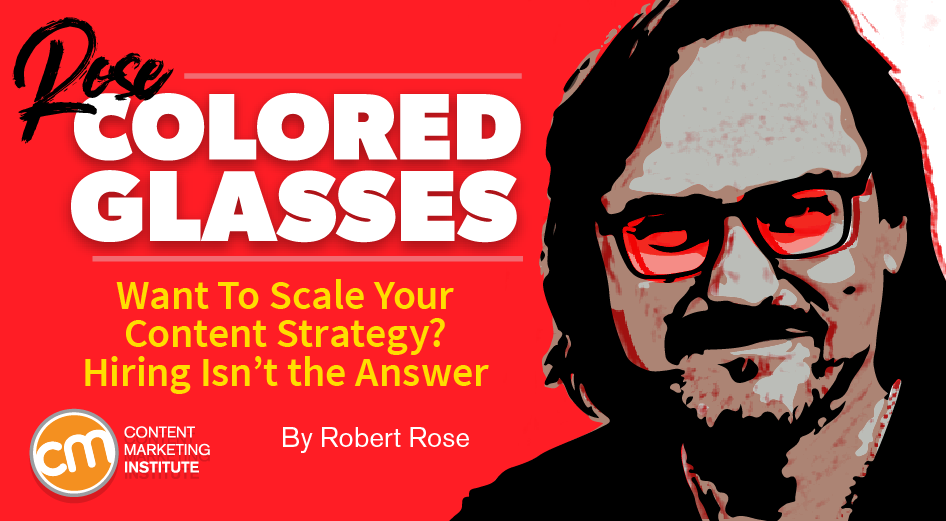MARKETING
Want to Scale Your Content Strategy? Hiring Isn’t the Answer

If you ask an actor or screenwriter about their career goals, they’ll almost all say, “But what I really want to do is direct.” Or so goes the Hollywood trope.
Ironically, the director participates the least in the creative work. A director’s role isn’t to write, act, play music, edit, or even point a camera. The director’s job is to direct the individual artists’ contributions to the film product.
Yes, some directors do double duty by writing or acting in their films or shows. But the director’s function remains clear: Guide, enable, and manage a team of storytellers to efficiently produce powerfully engaging work.
Successful directors shape the work of hundreds of independent artists so effectively the resulting film sings with one clear voice. The words, pictures, actors, costumes, music, and editing mesh so completely that removing any of them would pull the entire piece apart.
Transcendent directors do this so successfully that their signature style shines through even when they use different individual contributors for each project.
This idea of the director role came to me as I talked with the head of content at a B2B technology company recently. She told me that her content studio had earned enough respect within the business that they’re considered the go-to team for getting something written or designed well.
But she’s frustrated that most people considered them just the team that produces “good words and pictures.” She wants the team to play a more important role. So, she asked me, “How do we become more strategic to the business without adding more head count? How can we take on more content?”
Without a doubt, scalability is the biggest challenge I see among businesses trying to succeed with content marketing. The ability to “create enough content” gets mentioned as one of the top challenges in our content marketing research year after year.
Somehow, adding more writers, designers, podcasters, and other skilled staff never seems to solve that challenge.
Here’s the thing: The ability to grow doesn’t lie in the capability to produce enough content.
To scale, a content strategy team must be more than the collection of skilled creators of “good words” or “good pictures.” The content team’s purpose must be more than to create great assets.
It must also enable every other part of the business to do the same. What you need is a team that really wants to direct.
Your #content team must have a purpose beyond creating great content assets to be truly strategic, says @Robert_Rose via @CMIContent. Click To Tweet
Why you’ll never create ‘enough’ content
One of the biggest strategy mistakes I see is to equate establishing a content strategy with building a content studio filled with talented writers, designers, and multimedia specialists.
Even when there’s one person who manages the team, many in the business consider it a collection of individual contributors whose roles are to produce assets as efficiently as possible.
Spoiler alert: This approach rarely works. Why? Because businesses can’t get ahead of the content need.
Call this Robert’s Law of Content: The need for content expands in direct proportion to the number of resources allotted to it.
The need for #content expands in direct proportion to the number of resources allotted, says @Robert_Rose via @CMIContent. Click To Tweet
An intelligent content strategy in modern business isn’t about creating a siloed group of individual content contributors.
Instead, it’s about creating a team whose role is that of a director. Everyone on the team should be focused on helping create, guide, and enable the entire organization to tell a consistent story.
“Now wait just a doggone second,” you say. “How can a team of people all act as a director? Isn’t the director one person?”
Yes, that’s true. I mean that the function of a content strategy team is like that of the modern movie director.
The team isn’t there to provide any single content creation skill on demand. It exists to enable the broader organization to develop and integrate its messages into a common voice.
Like any seasoned director, the team also may do double duty as writers, editors, or designers. But that’s not their primary purpose.
They’re not simply providers of words that a sales professional copies and pastes, attaches to an email, or uploads to a website to create and deliver value to a customer, for example.
They should guide, shape, and develop the sales professional’s ability to deliver the best story regardless of who creates it. Occasionally, that might be someone on the content strategy team.
But an integrated, enterprise content strategy must work like a film project – it’s a director’s medium. The only way to truly scale is to shape, guide, and, yes, direct everyone in the business to do their part in telling the brand’s stories in one voice.
The only way to scale an enterprise #ContentStrategy is to direct everyone in the business to do their part in telling the brand’s stories, says @Robert_Rose via @CMIContent. Click To Tweet
My advice to any content leader looking to scale a team and become more strategic is to buy every team member a shirt that says, “But what I really want to do is direct.”
Then, start coaching the team to stop acting as an internal content production studio and start directing all enterprise content regardless of who creates it.
5 strategic enterprise content strategy roles
To facilitate this evolution of a content strategy, you need a new team charter that defines the content strategy team’s roles, responsibilities, and functions.
I see five primary responsibilities for the team. Each balances individual contribution with skills to foster in the broader organization.

1. Strategy: Planning and prioritization
This piece is missing in most content strategies where the team is seen as individual contributors. “Random acts of content” happen when no team accepts the role of leading the planning and prioritizing for which content will be produced and when.
A great director provides a consistent storyboard, shot calendar, timeline, and plan so everybody knows what gets created and when. Likewise, a content team must help the business with setting content objectives, distributing resources, and balancing priorities and business needs.
2. Content creation and management
This step is the most misunderstood because it’s the one most people think they understand. (“It’s just creating the assets as they’re needed, right?” No, it isn’t.)
Once you have prioritization, scheduling, and resource planning under control, the process becomes less linear yet more efficient.
Does that seem confusing? Think of it this way: A movie director might send one team off to shoot what’s called b-roll. (Think establishing shots, crowd shots, or filler shots that establish context).
This kind of filming can happen any time (not just as needed) because everything is planned out. The director describes what’s required but doesn’t have to provide it or even be present when these scenes are filmed.
Likewise, a great content manager might lead (but not create) content captured by someone in account services. The assets the account services staff captures can be remixed into case studies, marketing pieces, advertising, thought leadership, and so on. The person in account services knows what to produce because the content team member provided a complete “shot list,” set of interview questions, etc.
3. Merchandising: Internal scheduling and distribution
Merchandising is another area missing from many content strategies. Most companies conflate the idea of content assets and digital assets. They think, “We’ve created X e-books, web pages, and emails, so we’ve created X content assets.”
So much time ends up wasted by having to “undo” digital assets to retrieve content for repurposing.
One of the most critical roles on a film set is the production asset manager. That person ensures every asset (film, audio, video, photos, and so on) gets tagged and routed to the artists who need to create content with it.
Likewise, a great content strategy team ensures that both raw content and the resulting digital assets are easily findable, routed correctly, and available ready for reuse, repurposing, and activation.
HANDPICKED RELATED CONTENT:
4. Activation: Publishing and promotion
The responsibility here is not just completing the asset and saying, “Here it is.”
Equally important is the broad communication that it’s available and the plan for distributing it. While film producers (studios) typically promote a film, directors often have creative input into the marketing, trailer, and sometimes distribution.
A strategic content team also should ensure assets get launched appropriately.
5. Measurement: Insight and improvement
This final responsibility may seem, at first, to be the furthest from the director metaphor. Certainly, business content should be evaluated based on how well it was activated, promoted, and used. That usually means the responsibility should lie within whichever function of the business was responsible for distributing and using the content created.
You may be surprised to learn how much technology, data, and measurement processes are used on film productions to create more efficient scheduling, creation, and post-production efforts.
Likewise, the content team should, at the very least, be squarely focused on an efficient and effective lifecycle of content creation, management, production, and distribution.
Content strategy as artful, efficient production
These five responsibilities form the core of a content strategy. In addition to being a creative engine for artful experiences, a functional content strategy guides the entire process of content.
The team sets standards, develops playbooks, molds the scripts, chooses the lenses, fosters the talent, guides the process, and helps structure the output.
Like a movie, television, or stage director, your content team may sometimes, but not always, serve as the storyteller. But it should always, not just sometimes, enable everyone in the company to tell the business’s stories.
Once your team accepts its role as the “director” of enterprise content, it can start influencing vision, words, story, and experience to deliver on a business strategy poised for box office success.
HANDPICKED RELATED CONTENT:
Get Robert’s take on content marketing industry news (in just three minutes)
Cover image by Joseph Kalinowski/Content Marketing Institute







![Scale Efforts and Drive Revenue [Webinar] AI & Automation for SEO: Scale Efforts and Drive Revenue](https://articles.entireweb.com/wp-content/uploads/2024/10/Scale-Efforts-and-Drive-Revenue-Webinar-400x240.png)
![Scale Efforts and Drive Revenue [Webinar] AI & Automation for SEO: Scale Efforts and Drive Revenue](https://articles.entireweb.com/wp-content/uploads/2024/10/Scale-Efforts-and-Drive-Revenue-Webinar-80x80.png)










You must be logged in to post a comment Login